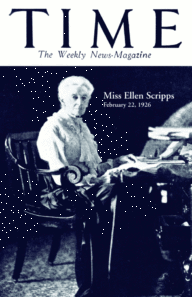

Country of origin: England
Year came to U.S.: 1844
Education: Certificate, Knox College
Organizations: Scripps Institution of Oceanography (1903), Scripps Health (1924), Scripps Research Institute (1924), Scripps College (1926)
Scripps Health Headquarters: San Diego, CA
2019 revenue: $3.3 billion (Scripps Health), $412 million (Scripps Research), $105 million (Scripps College)
Scripps Health U.S. employment: 17,443
Scripps’ wise investments allowed her to support important social and scientific developments in California.
Scripps Health today ranks among the top 10 health systems in the U.S.
“Aunt Ellen had the heart of a nurse, the courage of an astronaut and a capacity to give both generously and wisely.” –nephew Thomas O. Scripps
When Ellen Browning Scripps graced the cover of Time in 1926, she was called “the most beloved woman in Southern California.” Nearly a century later, her legacy lives on in the California hospitals and schools she funded out of her “capacity to give both generously and wisely.”
After her mother died, Scripps emigrated from England with her father and five siblings and joined her relatives in Illinois. Scripps was a precocious girl and an avid reader. At 16, she began teaching to pay for college. Since women at that time did not receive four-year degrees, Scripps graduated from Knox College in 1858 with a certificate.
Her career took off when her brothers ventured into the print world. James founded the Detroit Evening News in 1873, and E.W. later founded the Cleveland Press. Scripps invested her money and began editing and writing.
Her hard work and investments paid off. Cleveland Press expanded into a 24-newspaper chain, and Scripps amassed a small fortune. When an older brother died in 1900, Scripps inherited $600,000. She settled in La Jolla, California, and made new investments.
Scripps’ first contribution was to establish a marine station in San Diego. She gave more than half of her inheritance toward what would become the Scripps Institution of Oceanography at the University of California San Diego. She went on to help found Scripps College, the Bishop’s School, a public library, natural history museum, zoological garden and research laboratory, and a “welfare building” to help people in need.
The most famous parts of her legacy, Scripps Health and Scripps Research Institute, grew out of the Scripps Memorial Hospital and Metabolic Clinic, which she founded in 1924 when she was inspired by the discovery of insulin. Today, Scripps Research Institute is one of the largest, not-for-profit independent biomedical research institutions in the world. Scripps Health has grown into a $2.8-billion private, not-for-profit integrated health system in San Diego comprising four acute-care hospitals, 23 outpatient centers and clinics and 2,600 physicians who treat more than 700,000 patients each year. Today, it ranks among Fortune’s “100 Best Companies to Work For” and Thomson Reuters’ “Top 10 Health Systems in the Nation.”
Learn about other iconic female immigrants in the blog post Eight Famous Women Immigrants in the United States.
Updated July 2022
